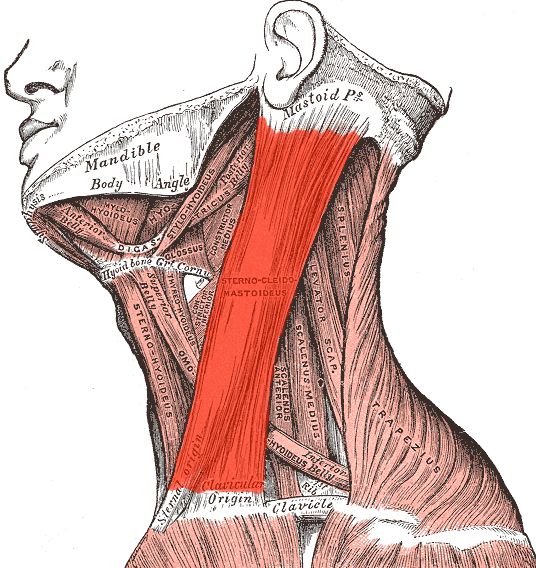yogabook / muscles / neck / sternocleidomastoideus

Linkmap

Sternocleidomastoideus
Craniocingular muscle of the shoulder girdle inserting at the mastoid (thickening behind the ear), medial third of the clavicle and sternum(cranial to the manubrium), which rotates the head horizontally and laterally flexes the cervical spine when innervated on one side, which means that it has to work significantly when the longitudinal axis of the head is clearly inclined against the direction of gravity, for example horizontally, and the face is pointing in a roughly horizontal direction. If the head is then also rotated, the sternocleidomastoid muscle is put under massive strain. Unfortunately, many sources give incorrect or incomplete information about its action when it is innervated on both sides: In the vertical position of the head, it undertakes a moderate extension of the cervical spine / reclination of the head. However, if the cervical spine is already slightly flexed, it supports further flexion performed against resistance (and gravity). Its function as a powerful (indirect, namely via the head) flexor of the cervical spine becomes clear at the latest when the head is raised from the supine position. If it were only an extensor of the cervical spine independent of the angle, its activity would press the back of the head to the floor in the supine position instead of holding the head in place and securing it against further gravity-induced extension of the cervical spine. This information is sometimes missing even in highly respected anatomical works. In addition, the sternocleidomastoid is an inspiratory respiratory muscle when the head is fixed.
Origin: Caput laterale: upper edge and anterior surface of the medial third of the clavicle; Caput mediale: anterior surface of the manubrium sterni of the sternum
Insertion: outer side of the mastoid process of the temporal bone and linea nuchae superior of the occipital bone
Innervation: Nervus accessorius and Rr. ant. of plexus cervicalis from C1/C2 – 4
Antagonists:
Movement: Innervated on one side: Lateral flexion and rotation of the cervical spine (indirectly via the head). Innervated on both sides: moderate reclination(extension) of the cervical spine in an upright position or flexion if the cervical spine is already slightly bent or the head axis is tilted backwards against the vertical as in the supine position; inspiratory respiratory support muscle.
Strengthening postures (): Strengthening (especially of the caput laterale) occurs through the ipsilateral rotation of the head, for example in twisting pose, jathara parivartanasana, maricyasana 1, maricyasanai 3, 2nd warrior pose, parsvakonasana. It is clearly intensified when the longitudinal axis of the head is in a more horizontal position, both with the face pointing upwards and with a horizontal gaze. In the first case, the sternocleidomastoid muscle has to work against the gravity-induced extension of the cervical spine: urdhva dhanurasana with raised head, navasana, purvottanasana – performed without reclination of the head in the second case against the gravity-induced lateral flexion inclination trikonasana, ardha chandrasana, parivrtta trikonasana, parivrtta ardha chanrasana, parivrtta parsvakonasana, parivrtta uttanasana, back extension: twisted.
Stretching postures (): As the origin of the two heads is quite close to each other, they are difficult to differentiate functionally. Stretching with regard to the rotational function (more caput laterale) occurs through contralateral rotation of the head, e.g. in twisting pose, jathara parivartanasana, parivrtta trikonasana, maricyasana 1, maricyasanai 3, parivrtta trikonasana, parivrtta ardha chanrasana, parivrttaparsvakonasanaparivrtta uttanasana, back extension: twisted2.Warriorposeparsvakonasanatrikonasana, ardha chandrasana.
